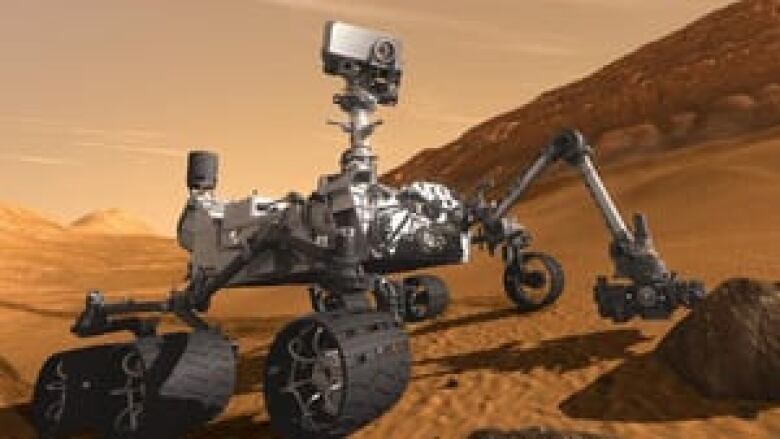Mars rover has a considerable Canadian connection
The Mars rover Curiosity is scheduled to landat 1:31 a.m. ET onAug. 6, on the red planet's Gale Crater, an area that scientists think will help unlock many secrets.
While Canadian scientists areat workon the mission, space enthusiasts worldwide plan to party and watch a live broadcast of the landing.
"The objective of the mission is to look and see if Mars ever had, or still has, the conditions to support life," said Stphane Desjardins, director of space exploration projects at the Canadian Space Agency. "We're expecting a great discovery from this mission."
Not only are a number of Canadians piloting Curiosity from NASA's Jet Propulsion Laboratory (JPL), they'll also direct the alpha particle X-ray spectrometer (APXS), a Canadian-designed component on the rover that's key to the mission's success.
The APXS was designed by a team of scientists from the University of Guelph, led by physics professor Ralf Gellert. The Canadian Space Agency footed the $17.8 million bill.
Searching for evidence ofwater on Mars
The APXS is a small box that functions like an X-ray machine that"determines the elemental composition of rocks, like how much silica and iron are inside," says Prof. Mariek Schmidt, a Brock University volcanologist.
Discovering certain minerals may indicate whether water existed in the past or even today on Mars.
"I expect to be surprised and I expect that all of us will be surprised," Schmidt says.
Schmidt, part of the team of Canadian scientists working on the Mars mission, is also one of the team members at the JPL who will be piloting the rover.
Schmidt's driven previous Mars rovers andlaughs when asked how to steer one.
"People would ask, 'Where's the joystick?' but it's through code and computer programming," Schmidt said.
Curiosity, about the size of a golf cart, is five times heavier than its predecessors, Spirit and Opportunity. And this new space vehicle has a whole lab on board.
Mars rover parties around the world
[IMAGEGALLERY galleryid=2863 size=small]
Before Canadian scientists even take Curiosity for a drive, they'll be glued to monitors at the JPL in Pasadena, Calif., throughout Sunday night and into Monday morning.
Schmidt and other scientists will be at a special event at the space centre.
"I'm sure it's going to be a real party atmosphere," she said. "There might be champagne."
Several Mars landing partiesare planned around the world, too.
Bill Nye the Science Guy and about 3,000 others are expected to attend Celebrate Curiosity: A Party on Mars, just minutes away from the NASA space center in Pasadena.
This is one of about 40 Mars parties that will be happening around the globe, including one in Toronto.
Successful landing uncertain
Many of these events attract more than science enthusiasts, because part of the curiosity about Curiosity is the burning question: Will it even land safely?
Not even NASA can guarantee an answer.
Imagine a space vehicle accelerating into Martian atmosphere at 20 times the speed of sound. Outside the heat shield breaches 1,600 C. The parachute deploys and moments laterlander andcapsule separate. Rockets thrust the lander a distance away and it hovers above the Martian surface. Finally it lowersthe rover to the surface.
That's if everything goes according to plan.
It takes14 minutes for a signal to travel to Earth from Mars, so by the time NASAmission controlfinds out how the landing went, Curiosity's fate would already have been determined.

"That's just a tense thing to go through by yourself, in front of your TV or computer at home," Jonathan Moneta, the organizer of Toronto's Live Curiosity Landing Party, told CBC News. "We wanted to create a party so that we not only celebrate but also experience it together with each other as support."
The guests at the Toronto partywill watch the landing on NASA's feed. Special events for younger kids are also planned.
The last rover?
Space exploration fascinates Moneta, buthe and his friends decided to host the Mars party because they feltthe landing was not getting the attention it deserved. Moneta, who manages smart energy start-ups, said space exploration doesn't excite people anymore. And that's reflected in the budget cuts to both Canada's space program and NASA.
"NASA's budget has been cut so much that this is actually the last rover that they're intending on sending to a planet at the moment," Moneta said.
"Usually by the time they're ready to send a rover, the next major planetary expedition has already been in the planning stages. At the moment there is nothing like that."
Moneta hopes the images Curiosity beams back will awaken new interest in space exploration.
Corrections
- A signal from the Curiosity rover on Mars takes 14 minutes to travel to Earth, not seven as the original article stated.Aug 07, 2012 9:15 AM ET












_(720p).jpg)


 OFFICIAL HD MUSIC VIDEO.jpg)
.jpg)



























































































